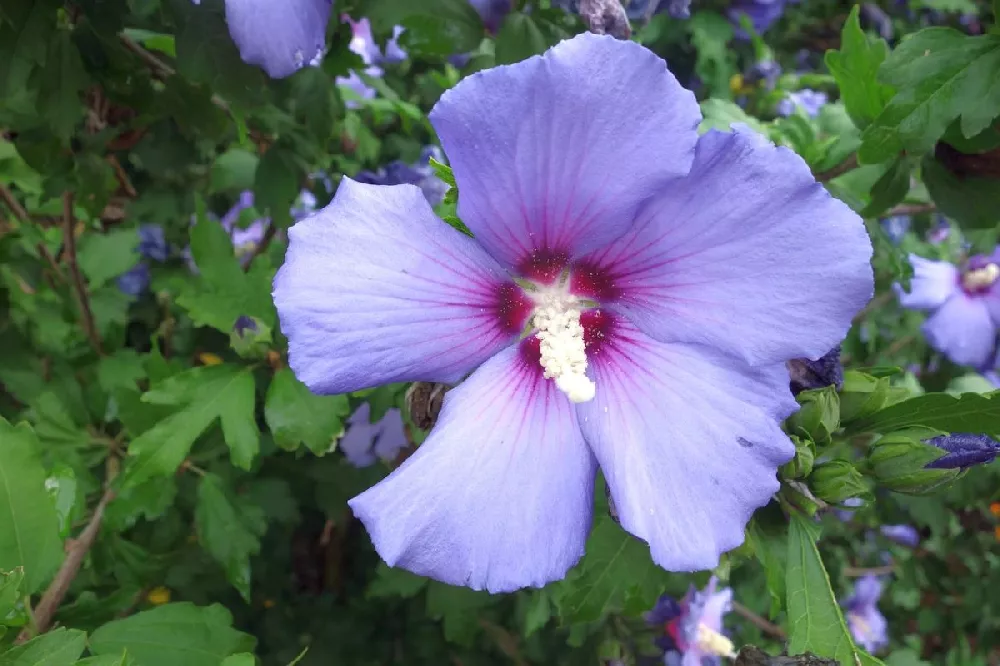- Home >
- Shrubs and Bushes >
- Bluebird Rose of Sharon Hibiscus Shrub
Bluebird Rose of Sharon Hibiscus Shrub for Sale - Buying & Growing Guide
Bluebird Rose of Sharon, Hibiscus syriacus 'Bluebird,' is definitely a shrub of another color. Unlike the usual hibiscus colors of pink and red, this cultivar offers large, deep purple-blue flowers with a red eye and white center. It is a long bloomer and will delight gardeners with flowers from midsummer until the first frost. Even when not in bloom, it's a handsome shrub with a rounded silhouette that makes it a great choice for informal, colorful hedges or privacy screens. In addition, Bluebird Rose of Sharon is an easy keeper that grows in just about any type of soil—including clay—and needs little extra care. Here are a few more reasons why you need one or more in your garden:
- Received Award of Garden Merit from the Royal Horticultural Society.
- Resistant to deer.
- Attractive to both pollinators and songbirds.
Enter your zip code to find nearby stores that may carry this plant.
Plant Care
Sunlight

Grow your Bluebird Rose of Sharon Shrub in full sunlight—at least six hours of direct sunlight a day.
Watering
Water whenever soil two inches below the surface is dry; usually about once a week.
Fertilizing

Fertilize with a slow-release, balanced product designed for landscape trees and shrubs.
Planting and Care
Planting instructions
Site your Bluebird Rose of Sharon where it will get at least six to eight hours of sunlight a day and in soil that drains well. Unpot your shrub and tease out any encircling roots which can girdle the tree and slowly kill it. Dig a hole that’s as deep as the root ball and twice as wide. Place the shrub in the hole and spread out the roots. Holding it upright and steady, fill in around the roots with topsoil—tamping down as you go to eliminate air pockets. Water thoroughly. Apply a two to three-inch layer of organic mulch such as bark chips around the root zone to conserve moisture and hinder weed growth but keep it from touching the trunk to avoid problems with rot.
Watering and nutrients
When newly planted, water your shrub every few days until you start to see robust new growth on the branches. Then scale back to once-a-week waterings unless it is very hot or dry—in that case, you should increase watering. In general, you can tell if your shrub needs water by digging down two inches near the plant—if the soil is dry there, give it a drink. Fertilize your Bluebird Rose of Sharon in spring with a balanced, slow-release fertilizer such as a 10-10-10 formula that’s designed for landscape trees and shrubs.
Pollination
Although Bluebird Rose of Sharon’s spectacular flowers are attractive to pollinators, it is a sterile cultivar, and the flowers are not part of a reproductive strategy for the plant.
Pruning
Prune out any dead, damaged or diseased branches whenever you see them. In early spring, prune back branches to an outward-facing bud to shape the tree or to encourage new growth.
Pests and diseases
The Bluebird Rose of Sharon has few insect pests or diseases that bother it. Keep an eye out for aphids, thrips and mealybugs, although a healthy shrub can generally handle mild infestations with little problem. If insect pressure is severe, consider releasing beneficial insects such as ladybugs and lacewings. Diseases that may occur on a rose of Sharon include leaf spot and leaf rust—both of which are fungal diseases. Always water at the base of the trunk to avoid wetting the leaves and space your shrubs appropriately so that there is good air circulation between them.
Achieving maximum results
Knowing how to use a Bluebird Rose of Sharon hibiscus shrub in your landscape is one way to achieve maximum results. This shrub is an excellent foundation planting and would work well near the back of a mixed perennial bed. It is tall enough that it can be used to create a formal or informal privacy hedge or border planting and would look splendid if planted on either side of a front entryway. It can also be grown easily in a container and placed in the corner of a patio or sun deck.
FAQs
How big does the Bluebird Rose of Sharon get?
This shrub has a mature height of six to eight feet, with a mature width of six feet. If planting multiples, be sure to space them at least three to four feet apart so that they are not crowded which can lead to conditions favorable to fungal diseases.
Where can this shrub be grown in the U.S.?
The Bluebird Rose of Sharon is hardy down to -10 degrees Fahrenheit and grows well in USDA hardiness zones five through nine. So, it will grow in northern regions except for the most northern parts of New England and the Midwest. It also thrives throughout most of the southern states except for southern Florida.
Is the Bluebird Rose of Sharon invasive?
No. It's true that some Rose of Sharon varieties are considered invasive, especially in the southeastern states, because they have a tendency to self-seed and spread widely unless controlled. But the Bluebird Rose of Sharon is a sterile cultivar that does not set seed; so, there is no danger of seedlings appearing around the bush.
Compare Similar Products
You can't add more Product Name - Product size to the cart.
OK








